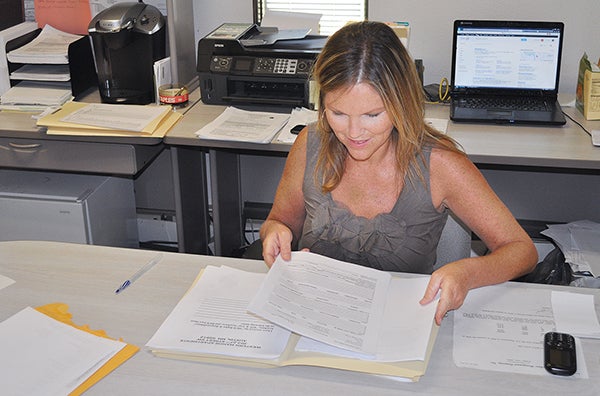Housing trends: A demand for rentals
Published 10:00 am Wednesday, August 1, 2012

Western Manor Apartments Manager Angie Goetz, who manages 72 units at the apartment complex, works in her on-site office last week. — Kevin Coss/kevin.coss@austindailyherald.com
Click here for the housing trend series
Number of renters increasing in Austin area
By Kevin Coss and Trey Mewes
Though the housing market is slowly but surely growing, rental properties are booming nationwide, as more and more studies show an enormous demand for apartments, condos and housing units for rent.
Locally, the rental market appears to be steady. The need for more rental housing is apparent, as the amount of rental units — which includes apartments and homes for rent — in Austin grew from 2,593 in 2000 to 3,229 in 2010, while the amount of renters in town grew in that same period from 5,154 to 7,521, according to the U.S. Census Bureau.
Dave Loverink, manager at Key Apartments for more than 20 years, said there have been some fluctuations in the rental environment, but the changes haven’t been too severe.
“It has slowed down a little and speeded back up again,” he said, adding that he’s starting to get more students in now.
Loverink said applications turned in at Key Apartments seemed to slow down a little over the last two years or so, but now are picking back up. He thinks the same thing is happening at other properties around town.
“The general tone seems to be similar,” he said.
Kevin Schammel, owner of Burr Oak Villas for about the last 10 years, said the 18 units at his property have stayed occupied lately.
“Our situation is full right now,” he said.
Angie Goetz works as manager at Western Manor Apartments, a property with 72 units. During her 14 years on the job, Goetz said trends have shown little significant change in occupancy or applications.
“The rental industry here in Austin is steady and we’re generally full,” Goetz said. “We usually have a waiting list.”
And while the rooms stay filled, it’s hard to say whether there’s a high turnover rate in residents at Western Manor, Goetz said, because it occurs on a case-by-case basis.
But just because there’s high occupancy doesn’t mean people are flocking into town and seeking out places to live. Very few people who rent at Western Manor are new to Austin, she added.
As for affordability, the cost to rent in Mower County may be low compared to statewide averages — the Fair Market Rent for a two-bedroom home in Mower County is $596, compared to Minnesota’s average of $806, according to the U.S. Department of Housing and Urban Development — but Mower County renters may not be able to afford such prices.
A report by the National Low Income Housing Coalition and Minnesota Housing Partnership shows the average renter’s salary, about $23,516, is slightly less than the $23,840 needed to afford a standard two-bedroom rental unit, assuming rent is about 30 percent of a renter’s expenses. The report further estimates about 50 percent of Mower County renters would be unable to afford that same two-bedroom rental unit. The U.S. Census Bureau found about 32 percent of Mower County rental households pay half or more of their wages to rent, according to the American Community Survey.
“There’s a huge shortage of rentals in this town,” said Mary Lindgren, a Realtor with Fuhrman Real Estate in Austin. “People can ask whatever they want.”
Lindgren added that actually helps the real estate industry.
Casey Hatch, broker and owner of Integrity Real Estate in Austin, said the between the foreclosures that came with the housing market crash four years ago and an influx of new jobs in Austin lately, the need for rental housing is extremely high.
“Those people need a place to live, and that creates a shortage of opportunities for them,” said Hatch, who is also treasurer of the Southeast Minnesota Association of Realtors.
Loverink said it was tough to tell what renters thought of the Austin area. He said the wide range in rental rates in town seemed to help cater to people of different incomes.
Economic strains are making their mark, however. Though the home market is slowly increasing, people nationwide are turning to rental properties faster than home ownership, which drives up rent and makes rental units scarce.
This could help explain why Loverink’s two properties at Key Apartments, which total 126 unit, have gone up in rent recently.
“We’ve had to increase a little bit due to taxing and other costs,” he said.
Over at Prairie Manor, Goetz reported the same.
“We had our first rent increase this last February,” she said, adding otherwise Western Manor hasn’t raised rates in the past 12 years.
Regarding the rental environment in Austin as a whole, Schammel said, the outlook for Burr Oak Villas is particularly promising going forward. Most of his units are occupied by people who work at The Hormel Institute, the Hormel Foods corporate office and Mayo Clinic Health Systems in Austin. With all three facilities seeing expansions, and workers being hired to fill new positions, he anticipated demand for his apartments will remain high.
—Adam Harringa contributed to this report.





